Why does Windows XP still drive in 2019, or WHY?
On Habré in the comments to the articles about the release of new versions of operating systems, the release of new models of laptops, data storage, memory modules, etc. The opinion is regularly expressed that only the latest version of the operating system of a well-known vendor allows a modern geek not to slip into a dull r ... o feel like a person, and only those who have Windows 8, 10, 11, 9000 installed (underline), will be popular with girls employers and customers. For the reasons stated below, I believe this opinion is deeply erroneous and even defective, showing the inability of the computer owner to make optimal use of the hardware and software resources at his disposal.
The following describes a system that, in 2019, enables its owner, a non- programmer working in IT, to easily handle all kinds of computer matters and is used for surfing the Internet, downloading torrents, doing home bookkeeping, email correspondence, and communicating with friends through audio and video conferences, interaction with banks and government institutions, creating presentations and lectures, amateur photo processing and creating and editing amateur home video (to view it on e on a computer), replenishing and maintaining a collection of music recordings (for listening to them not on a computer), recording archives on CDs and DVDs, etc., etc.
I purchased my laptop back in 2010 for 300 Canadian dollars (~ 250 USD). I always buy the cheapest computers, and already at that time the laptop could not boast of excellent characteristics:
I note that the cheapness of the computer made itself felt, and subsequently I had to change many components - the Hewlett Packard equipment is not famous for its reliability and durability. But the article is still not about the iron stuffing, but about the operating system and a set of programs and utilities that happily live under the control of an “outdated” OS on this unpretentious, especially by today's standards, hardware.
')
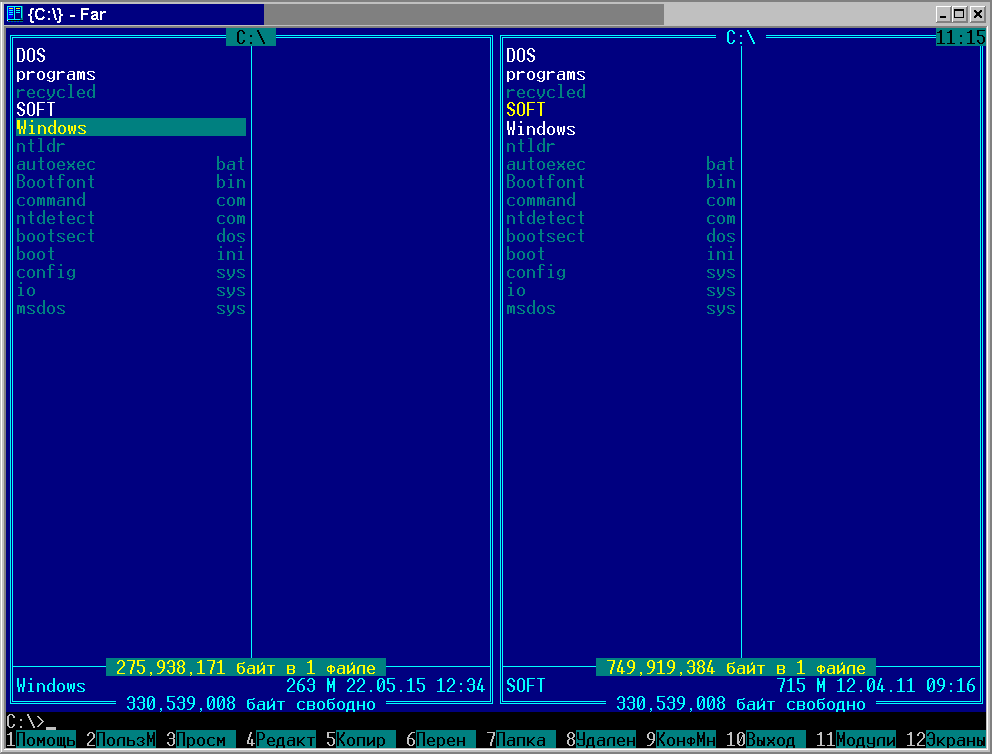
The laptop came with Windows 7 preinstalled. Having conjured up nLite, in order to embed the SATA driver for the hard disk into the installation files (this was required because the laptop BIOS did not have the IDE / SATA interface switch option), I was able to install Windows XP with the Service Pack 2, which after optimization began to work smartly in the following configuration:

Separately, I would like to dwell on disabling the paging file.
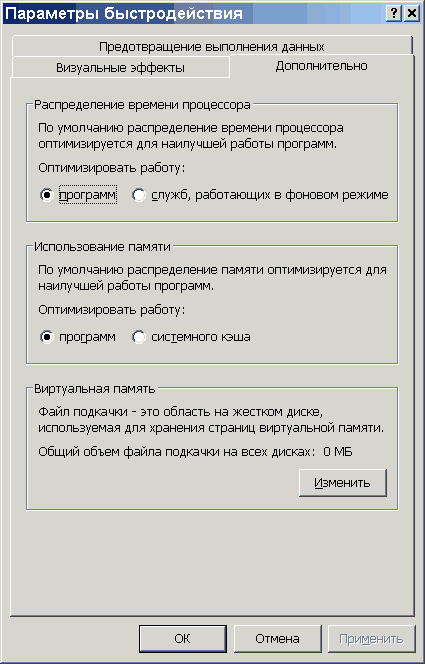
The need for a paging file in Microsoft operating systems is an extremely common myth - it is believed that when it is turned off, the system becomes completely inoperable, hangs, crashes, blue “death screens” appear, thehard drive switches to the resonant frequency, collapses and breaks the system unit to tatters ... From of all the horror stories, the real problem is actually one - when the running program consumes all the available RAM and drops, because it did not have enough memory. Well, in general, that's all. In computers that use demanding programs and packages (Google Chrome, IDEs , MS Office, etc.), it is enough to install a little more RAM, but in systems that do not work with large programs - 640 KB will be enough for all 2- 4 GB of RAM will be enough for comfortable work of the software - and the paging file can be completely turned off!
However, disabling a swap file carries many more advantages than using it: programs and utilities consume only fast RAM, do not write and constantly read data to / from a swap, work with user files is much faster because the operating system there is no need to expect when any of the programs will end up “swap”. We all faced with a situation when you need to quickly open / edit / print a file from a disk, and the computer “swaps”, the hard drive indicator is on without stopping, the system interface loses responsiveness, the manager screams, the customer stamps the legs and tears the hair onthe developer’s head - so, believe my many years of experience with a wide variety of workstations, that turning off a swap increases the speed of a Windows machine without exaggerating (!) And practically does not affect the stability of its work. I write “practically” only because I honestly note that program crashes happen, but they are rare, they can be predicted and successfully prevented.
When a new computer is given to me at a new place of work, after receiving administrative control over it, I first of all go to the system settings and turn off the paging file. Is always! I did this in Windows 98, XP, 7, 8 - and nowhere and never had problems with a lack of RAM and frequent program crashes. At the same time, it is quite clear that I would not do myself any harm, on the contrary - by disabling the swap file, I make my own work more efficient and keep the hair on my head for myself, developers, customers.

Twenty years ago, I lamented with friends about the fact that the programs began to grow in size, but this did not get any better. And at the same time, jokingly, he voiced the criterion of suitable software, which in its strong form sounded as follows:
, , 700 , — MultiTran (175 ).
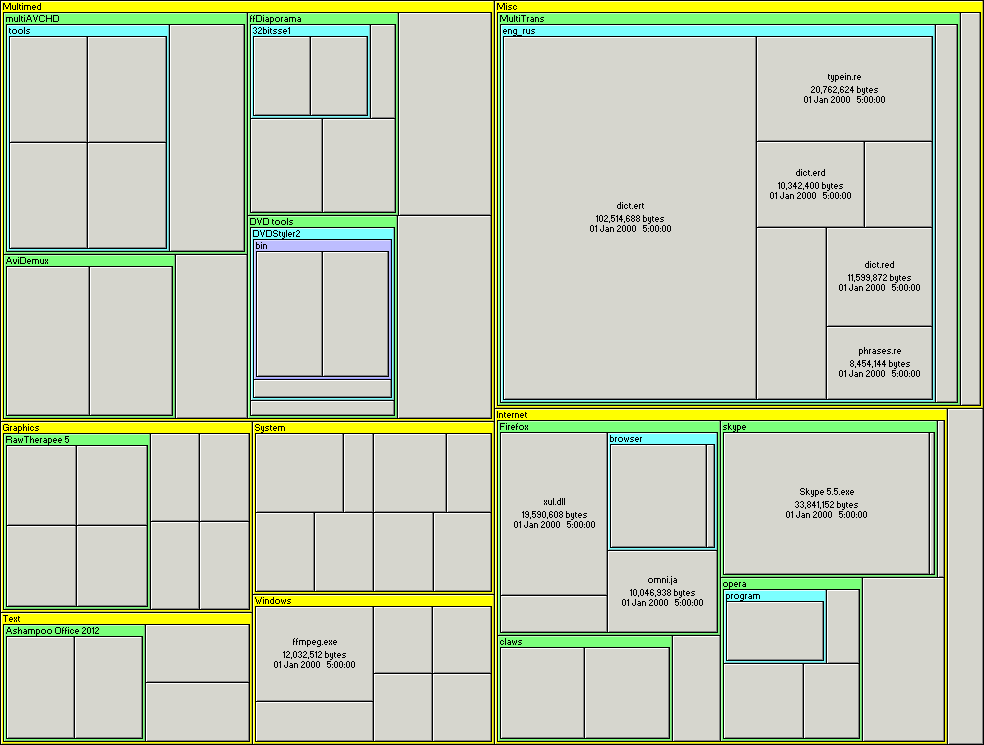
, ,
( ), Windows XP : 2- 3- ( , 3 — , Windows XP ) AMD Sempron 2.1 AMD Turion II 2.4 . , 13 , , , Cray: , halmacpi.dll halapi.dll halapic.dll, . , — : FullHD .
- , BBS- , « » — . , , «» , « » ( - , , ), — 130 , , .. , «» , «».
15 Windows XP - ,
The following describes a system that, in 2019, enables its owner, a non- programmer working in IT, to easily handle all kinds of computer matters and is used for surfing the Internet, downloading torrents, doing home bookkeeping, email correspondence, and communicating with friends through audio and video conferences, interaction with banks and government institutions, creating presentations and lectures, amateur photo processing and creating and editing amateur home video (to view it on e on a computer), replenishing and maintaining a collection of music recordings (for listening to them not on a computer), recording archives on CDs and DVDs, etc., etc.
Iron
I purchased my laptop back in 2010 for 300 Canadian dollars (~ 250 USD). I always buy the cheapest computers, and already at that time the laptop could not boast of excellent characteristics:
- Processor : AMD Turion II Dual-Core M600
- Processor frequency : 2.4 GHz
- Video Card : Radeon 4200
- RAM capacity : 2 GB
- Hard disk : 140 GB, SATA
- Drive : DVD-RW
- Expansion connectors and ports : 3 x USB 2.0, SD card reader, VGA, HDMI, ethernet, wi-fi.
I note that the cheapness of the computer made itself felt, and subsequently I had to change many components - the Hewlett Packard equipment is not famous for its reliability and durability. But the article is still not about the iron stuffing, but about the operating system and a set of programs and utilities that happily live under the control of an “outdated” OS on this unpretentious, especially by today's standards, hardware.
')
BY
Windows xp

The laptop came with Windows 7 preinstalled. Having conjured up nLite, in order to embed the SATA driver for the hard disk into the installation files (this was required because the laptop BIOS did not have the IDE / SATA interface switch option), I was able to install Windows XP with the Service Pack 2, which after optimization began to work smartly in the following configuration:

- RAM: ~ 300 MB,
- OS file size on disk: 211 MB (not counting the printer driver),
- page file: 0 MB,
- total absence of Internet Explorer and any of its libraries and tracks (except for the Content.IE5 and History.IE5 folders in size of 32768 bytes),
- running services:
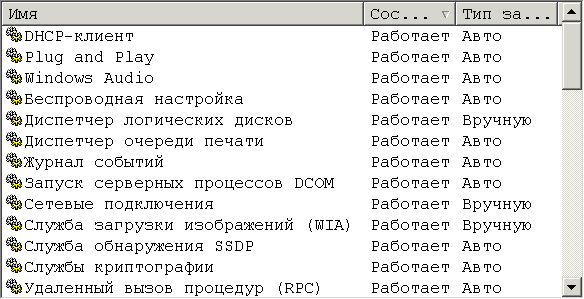
Most of the remaining services are either disabled or removed altogether (via Far), including the Windows update service, - Only one user is installed in the system: Administrator.
Separately, I would like to dwell on disabling the paging file.

The need for a paging file in Microsoft operating systems is an extremely common myth - it is believed that when it is turned off, the system becomes completely inoperable, hangs, crashes, blue “death screens” appear, the
However, disabling a swap file carries many more advantages than using it: programs and utilities consume only fast RAM, do not write and constantly read data to / from a swap, work with user files is much faster because the operating system there is no need to expect when any of the programs will end up “swap”. We all faced with a situation when you need to quickly open / edit / print a file from a disk, and the computer “swaps”, the hard drive indicator is on without stopping, the system interface loses responsiveness, the manager screams, the customer stamps the legs and tears the hair on
When a new computer is given to me at a new place of work, after receiving administrative control over it, I first of all go to the system settings and turn off the paging file. Is always! I did this in Windows 98, XP, 7, 8 - and nowhere and never had problems with a lack of RAM and frequent program crashes. At the same time, it is quite clear that I would not do myself any harm, on the contrary - by disabling the swap file, I make my own work more efficient and keep the hair on my head for myself, developers, customers.
A set of programs and utilities

Twenty years ago, I lamented with friends about the fact that the programs began to grow in size, but this did not get any better. And at the same time, jokingly, he voiced the criterion of suitable software, which in its strong form sounded as follows:
" , , ."" , , .", , 700 , — MultiTran (175 ).

, ,
- Softmaker Office 2012 (TextMaker, PlanMaker, Presentations), $29. , - (16(!) , ), , Open Office, Libre Office, AbiWord . MS Office- — , , . Softmaker Office DOC XLS, . , Presentations , Powerpoint, .
- EssentialPIM. , , , $19.95. «», 36 , 6.57 - Windows 8 .
- AbilityCash. , 10 .
- ACDSee Classic 2.43. RAW (), - . , , — Ctrl+R.
- Foxit Reader PDF 2.3. PDF- PDF-, Adobe Reader.
- Firefox 52.9 esr — , Windows XP, , 12.18 “”.
- . :

Nuff said. , IE - , , DLL- ( nLite; — 159 ) — .
- ( ) «.»: 24 .
- :
- Opera 12.18: 2 .
- Firefox: 13 .
- ClawsMail: 2 .
- TextMaker, FAR: 2 .
- FoxIt Reader: PDF- FAR: 2 .
- Skype 5.5: 3 .
- ACDSee: <1 .
- RawTherapee 5.0: 7 .
- WinAmp 5.33, mp3- FAR: <1 .
- PowerAmp 1.6: 2 .
- Dual-boot. : Windows XP MS-DOS. MS-DOS , .
- . Windows XP . Softmaker Office ( Windows), . ,
, , , , . - .Net Framework.
.; , — , ? - Skype.
-5.5,-Windows XP, MS . - . Windows , :
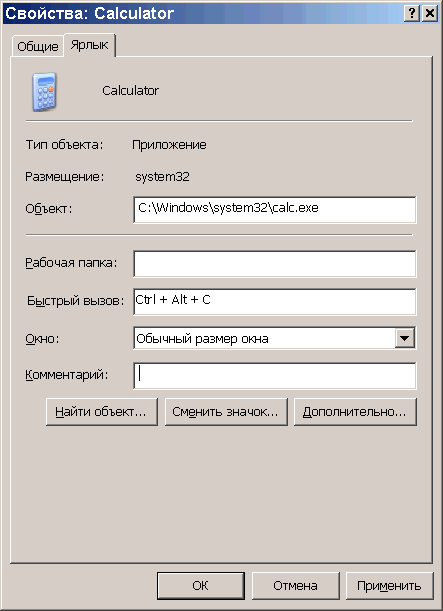
, . ( Ctrl+Alt+ Ctrl+Shift+, ):- Calculator (Ctrl+Alt+C)
- MultiTran, .-. (Ctrl+Alt+M)
- FS Capture, (Ctrl+Alt+S)
- WinAmp (Ctrl+Alt+W)
- PotPlayer (Ctrl+Alt+P)
Upgrade
( ), Windows XP : 2- 3- ( , 3 — , Windows XP ) AMD Sempron 2.1 AMD Turion II 2.4 . , 13 , , , Cray: , halmacpi.dll halapi.dll halapic.dll, . , — : FullHD .
?
- , BBS- , « » — . , , «» , « » ( - , , ), — 130 , , .. , «» , «».
15 Windows XP - ,
Source: https://habr.com/ru/post/434594/
All Articles